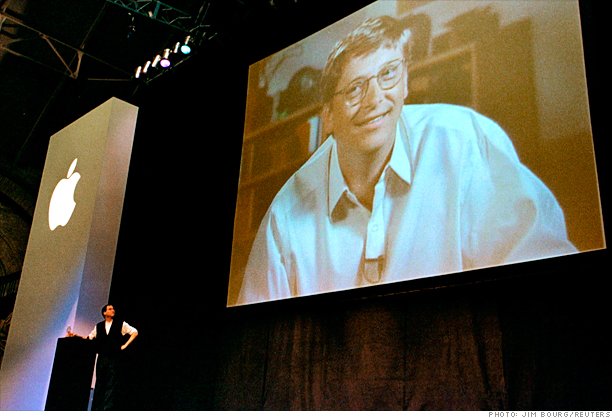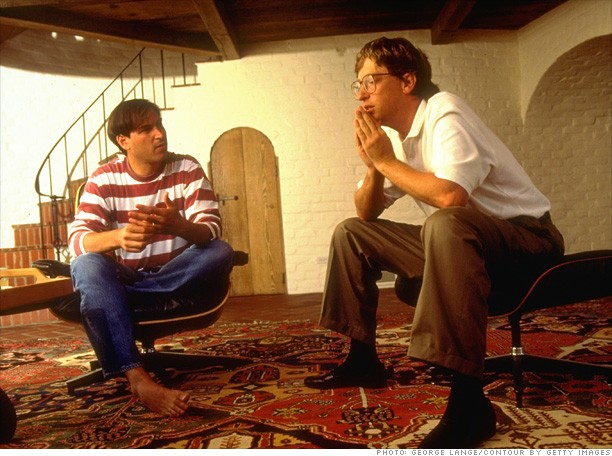Steve Jobs’ Mac Expo Keynote Address 1997
“We have to get over this attitude that for Apple to win, Microsoft has to lose. The industry wants cooperation.”
— Steve Jobs
Boston, Wednesday August 6, 1997 – The inconceivable has become common place. The collapse of the Soviet Union, the fall of the Berlin Wall, and the end of Apartheid were all dreams of science fiction a few short years ago. The Beatles somehow re-forming to produce new music and the possibility of life on Mars are all changes so big that we can barely grasp them.
I was present on that historic day of August 6, 1997, when the Apple/Microsoft peace accord, which had been brewing for nine months, was finally agreed on and announced. No heads rolled for this war to end. It seems that like many other battles, people were simply tired of a fight that no longer made any sense.
At 7:00 AM Wednesday morning, the line outside of the Boston Park Plaza Castle was two blocks long. Hordes of the faithful were hoping for a glimpse of Steve Jobs, already crowned as Apple‘s pre-destined saviour. Talking heads with perfect hair were lined up on the sidewalk, speaking live to TV viewers everywhere, speculating on what Steve might say. Power Computing, one of the leading Mac Clone makers, had taken advantage of the event by having teams of black-garbed storm troopers hand out protest signs that read, “We Demand Choice!” in an effort to garner support for their side in the Macintosh licensing negotiations.
The second coming was scheduled to start at 9:00, but the doors opened at 7:30. Hundreds of people swarmed in, quickly filling up almost every seat in the hall. Grateful Dead music was playing along with images of peace signs and smiling-happy-users shown on the huge projection TV screen up front.
The first indicator that something unusual was going to happen came early on: There were people from Microsoft sitting in the VIP section. When warned that his seat was reserved for Apple VIPs only and that he might be kicked out, one Microsoft employee replied, “You’ll find out why I’m here.”
Most people in the press were very polite, but some let their fame get to their head. There was one woman from CNN who walked up to my row, pointed at my chair, and said to me, “I’m with CNN, we’re going to need these 3 seats,” obviously expecting me to just give up my seat to her. I looked at her with an “I’m not the usher, lady” expression so she tried the same trick with someone in the row in front of me. The results were no different. CNN ended up sitting in the “Special Needs” section.
The show started with Colin Crawford, President and CEO of Mac Publications, who ran through a five minute slide-show media history of Apple, concluding with a 1984 picture of Steve Jobs introducing the original Macintosh. “A man who needs no introduction” couldn’t get one due to the deafening applause.
I last saw Steve Jobs about ten years ago, when he introduced the NeXT at Boston Symphony Hall. For that presentation, he wore all black with a black turtleneck. Today, he wore black with a white, long-sleeve shirt under a black sweater vest.
Unlike his NeXT presentation, which was mostly an operating system and hardware demo, Steve talked about larger issues: What makes Apple great and what needs to be done to make it better. He said that Apple employees are great people but that they are following a bad plan – that Apple needs direction.
The first step in this “new direction” is a new board of directors for Apple. Steve somehow convinced most of Apple‘s previous board to fire itself. The new board consists of two continuing members: Ed Woolard, Chairman and former CEO of Du Pont, and Gareth Chang,
President of Hughes International. The four new members are Larry Ellison, CEO of Oracle; Jerry York, former CFO of IBM and Chrysler; Bill Campbell, the CEO of Intuit, who was part of Apple and Claris “back in the heydey” – Oh, and one more guy, someone named “Steve Jobs, CEO of Pixar.”
He said that a new chairman of the board had not yet been decided on, since that decision will be made when a new CEO comes in – who also had not yet been chosen. According to an anonymous source, one of the conditions of Microsoft‘s investment was that Steve Jobs could not be Chairman of the Board.
Apple is going to focus on the section of the market where they are strongest: “creative content” and “education”, hoping to build a strong foundation for future growth.
They also plan to take advantage of their “core assets”: The users, the Apple brand name, and the Mac OS. Steve stressed that since Mac OS 8’s release two weeks ago, it has sold 1.2 million copies. Apple feels that the Mac OS is a wonderful product and plans to support it
long into the future.
Another key element of Apple‘s new plan is to forge relationships with “meaningful partners” – relationships that actually mean something beyond a press release. The only “meaningful partner” that he talked about was Microsoft, at which point the first boos and hisses were heard.
The agreement with Microsoft includes:
- A five year patent cross license for all patents of both Microsoft and Apple, and for all patents issued in the next five years to either company. It was not clear whether or not this cross license agreement includes any elements of Rhapsody. Steve neglected to mention that Microsoft will be paying an un-disclosed amount to Apple as part of this patent agreement.
- Microsoft will develop and support Microsoft Office for Mac for at least the next five years.
- Internet Explorer will be the default web browser on all future Mac OS releases. In response to the groans, Steve pointed out that “Apple believes in choice – we will also ship Netscape and other browsers. It’s not too hard to change your default.”
- Apple and Microsoft will collaborate on their Java technology development.
- Microsoft will buy $150 million of non-voting shares in Apple, and agree to not sell them for the next 3 years.
Steve then surprised almost everyone in the audience by saying, “I happen to have a special guest with me today via satellite.” He waved his hand and Bill Gates, wearing a white shirt that matched Steve’s, appeared on the gigantic projection screen TV – much like the image of Big Brother in Apple‘s 1984 Macintosh commercial.

Bill was greeted with a mixture of boos, hisses, and applause, which visibly shook him. He launched right into his talk, about how the Mac is great, how Microsoft has a special Mac development team dedicated to developing and supporting true Mac versions of Mac Office 98 and Internet Explorer. He didn’t mention it, but this team mostly consists of former Apple employees.
For the final strike in Bill and Steve’s successful effort to defuse the anti-Microsoft sentiment in the audience, Steve announced, “We’re mature now; we have to get over this attitude that for Apple to win, Microsoft has to lose. The industry wants cooperation.” Looks like the cold war is over.
Wrapping up, he talked about the Apple brand: One always had to be a little different to buy an Apple. In the beginning, with the Apple II, you bought a machine “with an installed base of one” and had to figure out everything by yourself. When the Mac was introduced, the tools were provided for thinking differently, for “the crazy geniuses.”
Maybe it’s more like John Lennon convincing the Beatles to join Oasis.

Whatever Apple and Microsoft agree to do, it’s a standard.”
— Steve Jobs